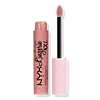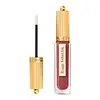NYX Cosmetics Lip Lingerie XXL Long-Lasting Matte Liquid Lipstick Versus Bourjois Paris Rouge Velvet Ink Liquid Lipstick
What's inside
What's inside
 Key Ingredients
Key Ingredients

No key ingredients
 Concerns
Concerns

 Ingredients Side-by-side
Ingredients Side-by-side

Dimethicone
EmollientIsododecane
EmollientTrimethylsiloxysilicate
EmollientNylon-611/Dimethicone Copolymer
Skin ConditioningDimethicone Crosspolymer
Emulsion StabilisingC30-45 Alkyldimethylsilyl Polypropylsilsesquioxane
Lauroyl Lysine
Skin ConditioningTriethoxysilylethyl Polydimethylsiloxyethyl Dimethicone
Skin ConditioningSilica Silylate
EmollientIsopropyl Titanium Triisostearate
EmollientSorbic Acid
PreservativePhenoxyethanol
PreservativeParfum
MaskingCI 15850
Cosmetic ColorantCI 45410
Cosmetic ColorantCI 77491
Cosmetic ColorantCI 77492
Cosmetic ColorantCI 77499
Cosmetic ColorantCI 77891
Cosmetic ColorantCI 19140
Cosmetic ColorantCI 42090
Cosmetic ColorantDimethicone, Isododecane, Trimethylsiloxysilicate, Nylon-611/Dimethicone Copolymer, Dimethicone Crosspolymer, C30-45 Alkyldimethylsilyl Polypropylsilsesquioxane, Lauroyl Lysine, Triethoxysilylethyl Polydimethylsiloxyethyl Dimethicone, Silica Silylate, Isopropyl Titanium Triisostearate, Sorbic Acid, Phenoxyethanol, Parfum, CI 15850, CI 45410, CI 77491, CI 77492, CI 77499, CI 77891, CI 19140, CI 42090
Isododecane
EmollientPolyethylene
AbrasiveBis-Carboxydecyl Dimethicone
EmollientC9-12 Alkane
SolventPolypropylene
Quaternium-90 Sepiolite
Emulsion StabilisingPhenyl Trimethicone
Skin ConditioningTrimethylsiloxysilicate
EmollientHdi/Trimethylol Hexyllactone Crosspolymer
Quaternium-90 Montmorillonite
EmulsifyingCoco-Caprylate/Caprate
EmollientParfum
MaskingSilica Dimethyl Silylate
EmollientPhenoxyethanol
PreservativeCaprylyl Glycol
EmollientLimonene
PerfumingUndecylenic Acid
CleansingSilica
AbrasiveTriethoxycaprylylsilane
Alpha-Isomethyl Ionone
PerfumingLinalool
PerfumingMica
Cosmetic ColorantIron Oxides
Acid Yellow 3 Aluminum Lake
Titanium Dioxide
Cosmetic ColorantAcid Blue 9 Aluminum Lake
Isododecane, Polyethylene, Bis-Carboxydecyl Dimethicone, C9-12 Alkane, Polypropylene, Quaternium-90 Sepiolite, Phenyl Trimethicone, Trimethylsiloxysilicate, Hdi/Trimethylol Hexyllactone Crosspolymer, Quaternium-90 Montmorillonite, Coco-Caprylate/Caprate, Parfum, Silica Dimethyl Silylate, Phenoxyethanol, Caprylyl Glycol, Limonene, Undecylenic Acid, Silica, Triethoxycaprylylsilane, Alpha-Isomethyl Ionone, Linalool, Mica, Iron Oxides, Acid Yellow 3 Aluminum Lake, Titanium Dioxide, Acid Blue 9 Aluminum Lake
Ingredients Explained
These ingredients are found in both products.
Ingredients higher up in an ingredient list are typically present in a larger amount.
Isododecane is a fragrance, emollient, and solvent.
As an emollient, it helps your skin stay soft and hydrated. Emollients help trap moisture into your skin.
Isododecane's role as a solvent makes it a great texture enhancer. It spreads smoothly on skin and does not leave a sticky feeling behind. Isododecane also helps prevent color transfer in makeup products.
Isododecane is not absorbed into skin.
Learn more about IsododecaneParfum is a catch-all term for an ingredient or more that is used to give a scent to products.
Also called "fragrance", this ingredient can be a blend of hundreds of chemicals or plant oils. This means every product with "fragrance" or "parfum" in the ingredients list is a different mixture.
For instance, Habanolide is a proprietary trade name for a specific aroma chemical. When used as a fragrance ingredient in cosmetics, most aroma chemicals fall under the broad labeling category of “FRAGRANCE” or “PARFUM” according to EU and US regulations.
The term 'parfum' or 'fragrance' is not regulated in many countries. In many cases, it is up to the brand to define this term.
For instance, many brands choose to label themselves as "fragrance-free" because they are not using synthetic fragrances. However, their products may still contain ingredients such as essential oils that are considered a fragrance by INCI standards.
One example is Calendula flower extract. Calendula is an essential oil that still imparts a scent or 'fragrance'.
Depending on the blend, the ingredients in the mixture can cause allergies and sensitivities on the skin. Some ingredients that are known EU allergens include linalool and citronellol.
Parfum can also be used to mask or cover an unpleasant scent.
The bottom line is: not all fragrances/parfum/ingredients are created equally. If you are worried about fragrances, we recommend taking a closer look at an ingredient. And of course, we always recommend speaking with a professional.
Learn more about ParfumPhenoxyethanol is a preservative that has germicide, antimicrobial, and aromatic properties. Studies show that phenoxyethanol can prevent microbial growth. By itself, it has a scent that is similar to that of a rose.
It's often used in formulations along with Caprylyl Glycol to preserve the shelf life of products.
This silicone is an emollient. Emollients create a thin film on the skin to prevent moisture from escaping.
It is not soluble in water and helps increase water-resistance in products.
According to a manufacturer, it can blend seamlessly with silicone oils, such as Cyclopentasiloxane.
Learn more about Trimethylsiloxysilicate